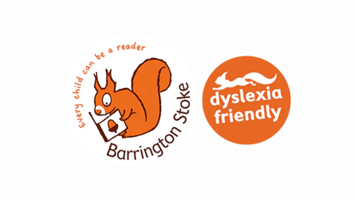How can you inspire a love of reading for every child in your classroom? Join us as we navigate...
Breaking Down the Barriers of Reading with Barrington Stoke - by Agostina Marozzi – International Sales Representative for Harper Collins.
Barrington Stoke became part of HarperCollins Publishers as an imprint within Collins in 2023, but it was born as a groundbreaking publishing house in 1998.

In 1998 a principal of a specialist school for dyslexic children, Patience Thomson, and a marketeer from Bloomsbury, Lucy Juckes, realised the need of high-quality books specially designed to be accessible for struggling and reluctant readers. Patience and Lucy, also mums with experience of dyslexia and reading reluctance at home, embarked on this journey over 25 years ago.
Now, Barrington Stoke is an award-winning publisher which specialises in publishing super-readable, dyslexia-friendly accessible books for a wide range of readers including those who are reluctant, under-confident or struggling to read. Over 400 inclusive short novels and non-fiction books that have been written exclusively for Barrington Stoke by award-winning authors and illustrators.
Read on to find out more about how Barrington Stoke helps break down the barriers of reading for those struggling and reluctant readers and how you can implement some of these strategies in your classroom environment to help every child enjoy reading.
The wont’s and the cant’s
Patience’s and Lucy’s starting point was identifying two types of readers, the won’t read, and the can’t read. They both knew that with the right approach, the right publishing, listening to young people themselves and working closely with educational psychologists and specialists, there was a way to publish appealing books, with quality stories that could unlock a love for reading.
- The Won’t-Reads
They are book-averse children. They may be disengaged from reading for different reasons. It could be due to a negative experience, or they might be easily distracted. They typically lack confidence and self-esteem when it comes to their reading ability and this contributes to their aversion of books.
- The Can’t-Reads
They are children who are generally performing below their age-related expectations. They may have processing difference, or visual perceptive difficulties. They may have a diagnosis of a condition such as dyslexia, visual stress or Irlen Syndrome. English may not be their first language, so there there’s a language barrier there for them. They might have missed school at crucial points in their developmental years.
These two categories are not mutually exclusive, and no two children are the same. Just because a child won’t read, doesn’t mean that they can’t read and vice versa. Many children who fall in the Can’t-Reads category in fact year to engage with books, and you might find these children picking up certain types of books which contain less text such as picture books, comics and graphic novels.
The Typical Barriers to Reading
Some of the typical barriers readers can find in a book include the subject, theme or topic of the books, which may fail to engage the readers. If a reader doesn’t find the topic interesting or they can’t relate to the story or characters, it’s easier to put down the book.
If a book is too long or has a difficult structure to follow, think chunky spine, long chapters or even no chapters at all, it can be really hard to focus or even to break the book into digestible chunks.
The language of a book, if it’s too complicated, overly convoluted, complex or above the reader’s reading age, then readers can quickly disengage. Visual barriers such as design, layout and font of a book, can also be tremendous barriers for those who struggle with visual stress or dyslexia. The composition of a book, how the book is printed and produced, as well as the child’s reading environment can also have a direct link with the engagement.
Removing the Barriers of Reading
What are the measures Barrington Stoke uses to remove these barriers?
Let’s first consider the length of the books. A wide spine can daunt and intimidate readers. Barrington Stoke asks their authors to write a shorter story than they would do for other publishers, no other restrictions are given other than a guideline on word count depending on the readers age and reading level. Short books are great for confidence and the sense of achievement that comes with finishing a book.
Having to write a short story is not an easy job. It takes great skills to grip and entertain readers from the very first page and to craft a powerful short novel. Approaching award-winning and experienced writers is key at the time to find a gripping story. Struggling and reluctant readers need the absolute best writing to keep them hooked and engaged. It’s also important that they are able to access stories from the same writers as their friends and classmates, it helps feeling included in the conversation.
Engage readers through themes, tapping into their interests and passion which might entice them to pick up a book. At the back of every Barrington Stoke books you can find three keywords for the book’s key themes.
A team of experienced editors go through a thorough language editing process including a dedicated second language editing. The vocabulary used in the books is familiar and age-appropriate but still inviting to a little challenge.
Design, Layout and Font
Having illustrations that aid comprehension, break up the text and provide rest breaks for those who might find reading tiring is of great importance, it can also show ideas that may be to complex to comprehend, but equally important is to have the text spaced apart from illustrations so as not to confuse the reader and maintain their attention. The cover needs to be contemporary and stylish; it needs to pass the “school bus test” – If the book falls out of your bag, are you ashamed or proud to pick it up?
The layout of the text is a precise art, they are spaced out so that the letters are not overcrowded but not too far apart that they can’t be linked easily. The font of these books is unique and trademarked, designed by eyesight and dyslexia specialists to be easily readable.
The composition of a book is also a measure to make it more accessible. Using specially tinted paper minimises any glare between the contrast of black letters on white paper. Do your students say that they see letters moving in a page? This tinted paper can settle the text and prevent distraction.
You will find all the features described above in all Barrington Stoke books, but they can also help you identify books from other publishers that may have some of these features, this way you can find books that are inclusive for all.
How can you make reading spaces accessible for everyone?
Find spaces with natural light, if you don’t have access to this then you can also use a full-spectrum light bulb. Natural light can help improve anxiety and increase concentration. Keeping fidgeting toys and sensory props can help self-regulate.
Select different seating options; cushions, beanbags, having a “book nook”. All of these are easy to find solutions that will create a relaxing leisure space so as to remove the classroom-like environment.
Signpost with pictures, produce labels or posters on cream tinted papers, use symbols, any signage will be useful to identify the books. Have you ever judged a book by it’s cover? Displaying outward-facing titles it can be less intimidating to make a choice of what book to read.
Set some time aside for reading, the DEAR approach can be very fun for children. Imagine being in the middle of a grammar class, the students are having a hard time concentrating, the teacher is there, the classroom in silence. All of the sudden the voice of the teachers shouts out “Quick! Hurry! Drop Everything and Read!”. The commotion makes every child grab their book and start reading. Even a session as short as ten minutes, scheduled regularly, can be plenty while building stamina.
Stock a wide range of books that speak to a variety of different life experiences. Provide opportunity for the students to develop empathy and understanding. Having their point of view reflected in a book can be a highly validating experience. Have a variety of formats and genres can be key to winning them over.
Sparking a love of reading is not an easy task, but we can best prepare our reading environment for learners by understanding their reading complexities and what can be done to support them. Books don’t need to be long, boring or complicated, sometimes hooking the reader in fewer words is the key to reaching a wider audience, making books accessible to everyone,
You can find more information on creating accessible spaces here.




